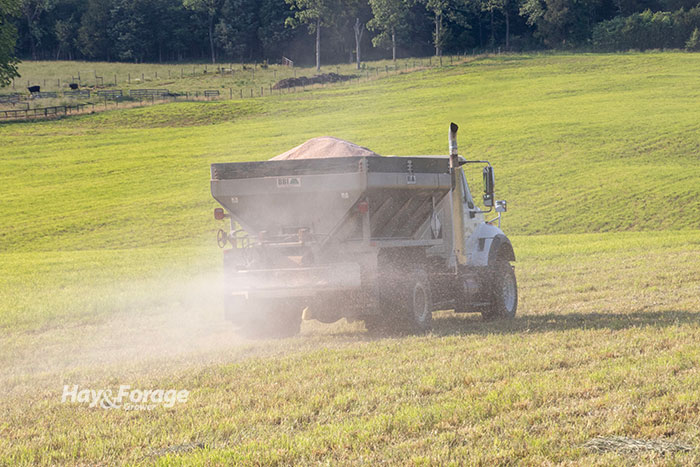
Fertilizer can be a critical piece in the forage production puzzle whether it is applied during stand establishment, after a hay harvest, or as a maintenance application. Although fertilizer costs had farmers crunching numbers during the second half of 2021 and the better part of 2022, prices have been on a descent for most of 2023.
Like most crops, forage species require nitrogen, phosphorus, and potassium in the greatest amount compared to other nutrients. Urea or liquid nitrogen, di-ammonium phosphate (DAP), and potash are some of the most common forms of fertilizer these macronutrients are applied as.
According to the USDA’s Agricultural Marketing Service’s bi-weekly production cost report released on July 27, urea and liquid nitrogen prices were $497 and $536 per ton, respectively, representing a 50% and 22% reduction in these fertilizer costs from their peaks in 2022. Likewise, DAP prices were $822 per ton — down 20% from prices that exceeded $1,000 per ton in June 2022 — and potash fertilizer cost $558 per ton with a 35% price decline since April 2022.
Carl Zulaf with The Ohio State University and Nick Paulson, Gary Schnitkey, and Jim Baltz with the University of Illinois explain this downward trend is likely a result from three major factors: demand destruction from high fertilizer prices last year, investments in expanding global production capacity, and market adjustments from the Russia-Ukraine conflict.
“As the saying goes, the cure for high prices is high prices, and the sharp increase in fertilizer and energy prices in 2022 led to demand destruction as farmers and consumers made adjustments to high price levels,” the economists state. “Coupling that with investments in expanding fertilizer production capacitates that have either come online over the past year or are expected to impact capacity in the coming year has also helped moderate fertilizer prices.”
Secure supplies now
Fertilizer prices — especially nitrogen fertilizers — are strongly correlated with natural gas and corn prices. The economists note natural gas, which is a key energy source for processing various fertilizer products, has seen a notable price decline since its spike in 2022. Average corn prices have also weakened since the commodity’s peak price of $7.38 per bushel recorded last June.
Although fertilizer prices are relatively lower than last year, they remain historically high. Markets have adjusted to the export restrictions and other disruptions caused by the Russia-Ukraine conflict better than expected; however, the economists caution producers of the constant underlying threat of future geopolitical developments that can negatively impact trade flow.
The economists encourage producers to take advantage of the situation before natural gas and corn prices rebound. “Natural gas futures indicate market expectations for prices to move from the current $2 range back to the mid- to high-$3 range over the next six months while corn futures currently suggest cash prices near or just below $5 per bushel for the 2024 corn,” they assert.
Overall, the downhill slope of fertilizer prices ultimately points toward better returns for farmers in 2023 and 2024. With that said, it may be best to secure fertilizer supplies now instead of waiting for prices to drop even further.
“These market expectations for corn and natural gas prices and current price levels for fertilizer products seem consistent with conditions during late summer and fall 2021 prior to the turmoil introduced by the Russia-Ukraine conflict in February 2022. Thus, it may be prudent to consider pricing at least a portion of 2024 fertilizer needs given the ongoing risks in the market,” the economists conclude.

